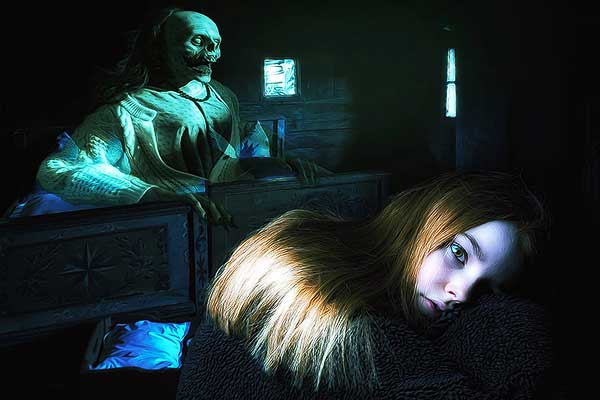Tips and Lessons for Folks Who Think They Might Want to Create a Haunt
by Scott Swenson
This blog is based on episode 31 of my A Scott In the Dark podcast, which was titled, Hey Gang, Let’s Put on a Show. This was geared toward folks who think they want to start a haunted attraction. First, a disclaimer: I’m usually hired by owners to act as the creative and operational guy, but I, myself, have never actually been a haunt owner or operator.
I’ve been hired by haunt owners and operators and have been intimately involved from initial concept to the financial pitches to investors to the operation and training throughout to the post-mortem to figure out what worked, what didn’t, and how to improve the following year. If you’re reading this to get all the answers on how to be a brand-new haunt owner, chances are good you’re not going to get all the answers. This blog is all about asking the right questions.
We’re going to shoot through a series of questions, I’m going to share my opinions, and then I want you to ask a professional haunter or a lighting designer these questions to see what their perspective is.
Listen Now:

There are a bunch of people out there who have had successful experiences—and not so successful experiences—who are just as passionate if not more passionate than you are about creating a haunt. If you love haunting, my suggestion is, make it a hobby, not a business. Be a home haunter, and be a great one. I don’t mean that to sound like home haunting is a secondary level of the haunt industry. What I’m saying is, if the reason you’re doing a haunt is because you have a passion to do it, a home haunt is probably what you should focus on, in my opinion.
It’s Going to Take a While to Make Money
If you have the passion, the business savvy, or a partner that has the business savvy, you might want to consider moving into a hobby that pays for itself or that could, quite possibly, earn a profit someday. Most haunted attractions don’t turn a real profit until about four or five years into their run.
If you’re starting from scratch and building from the ground up rather than trying to inhabit an existing space, it’s going to take some time to get return on your investment. It used to be five years, but now I’ve heard it’s actually closer to two or three. Work these two to three years into your business plan, and budget. If you can break even by year two, you’re being successful.

Offer Something Unique Not Just Less Expensive
The first thing I’d look at is, what are other people in your neighborhood or your neck of the woods doing as far as haunted attractions? Who’s your competition? You can’t just be scarier than the competition. Find something that elevates you, makes you different, and makes guests think you’re worth spending money on.
You’ve got to offer something different. If you’re undercutting everybody for a product of the same quality, great. That’s something that set’s you apart. If you can say, “We’re the only full-contact haunt in this particular area, and we’re the same price or less than the competition,” that’s good, but don’t lead with price. Once you lead with price, in my opinion, it makes people think, “Oh, they’re not worth it. They’re not even worth wasting our time. Let’s spend the extra two bucks and go do something we know is good.”
You Need to Budget
You have to have a budget. How much are you going to allocate for scenic, how much are you going to allocate for special effects, and what can you use year after year after year? What things will be gone through every night, like fog fluid or scent pops or things like that? How long can you use your costumes—one year, five years? How much are you going to spend to keep things going? If you budget for flashlights, you have to also think of batteries. How much is makeup going to cost, and how often are you going to have to replenish it? Is it cheaper to invest up front in masks and not use makeup? Or, is there a combination that works? Do you have it within your budget to do full-on prosthetics? Can you afford 10, high-end silicone masks, and the rest is makeup? You have to look at all these things when you’re budgeting.
Don’t forget to include insurance in your budget. Don’t operate without insurance. Don’t do it. You also have to look at things like, if you’re paying people, do you have a payroll service? Do you have a ticketing service? These all have to go into that budget, if you’re truly going to look at it like a business.
How many people do you think you can put through your haunt per night, and how much are they all going to pay? Don’t expect that your revenue is going to be based on a sell-out every single night. That isn’t reasonable. You won’t sell out every single night. I always tell my friends who do sit-down theater to budget income based on filling half of the seats in the theater.
You have to look at what it’s going to cost you, what you can use year after year so you won’t have to pay for that again next year, and what you have to pay for ongoingly—like labor, fog fluid, etc.—that you have to reinvest in 100%. You put those two numbers together and figure out, “Am I going to earn something, or am I not?” Like I said, I’ve never been a haunt owner, so I’m oversimplifying this. However, I can’t tell you how many new haunt owners I talk to that don’t even take most of these things into consideration any.

Be Aware of All the Costs, Especially the Hidden Ones
For example, many owners fail to think about how much they’ll pay themselves. They also often neglect the hidden stuff. They just look at, “I need walls, paint, and blood. Now, let’s do this.” And they end up losing their shirt. It becomes a very expensive hobby. So, you might as well make it a home haunt where you don’t have any expectations, and you’re not disappointed when it’s all over.
If you’re a charity haunt, get as many in-kind donations as possible. Put the logos of these sponsors in a prominent place. Send out donation letters so sponsors can take the tax deduction. If you’re a 501(c)3, ask for discounts on everything. Get as many of your materials as possible for free. Don’t be afraid to ask. Prominently promote the people and entities who help you.
The Physical Space Can be a Big Expense
Your location—the physical space—is one of your biggest expenses. Think about renting an empty commercial space for three or four months. You might get a cheap deal as a store filler. Be respectful of the landlord’s wishes. You can’t go in and start knocking out walls or drilling holes in places you shouldn’t be drilling holes. You also have to recognize that some landlords—actually, most landlords—want to be sure the people renting from them are reputable.
Always be professional. The moment a landlord hears that you have inappropriate business practices, you’re unsafe, or you’re not insured, chances are very good they won’t want you back next season. Communicate with your landlord, so they feel they benefit from you being there and you benefit from having that phenomenal location.

Consider an Outdoor Space
Don’t discount an outdoor space, like a corn maze, even though it presents special problems involving electric power (and perhaps insect spray). Battery-powered stuff is much easier than it used to be, especially with LED and lighting. Go to your local farmer and say, “Hey, let your crops go until the beginning of November, and let me carve a space out of it.” Get a big patch of vacant land and cut a pathway through the existing foliage. You might need to build fewer walls, and it will save significant amounts of money on the scenic costs.
Hire a Consultant for Areas Where You Need Help
There are consultants you can hire to help you think through almost any aspect of your haunt. Last year “Dark,” in Edmonton, Alberta—the competitor to “Deadmonton”—hired me to be their writer and creative director. I helped with casting, and I trained their staff, because it was their first year of doing a full-on, adult-themed—or, at least, not kiddie-themed—attraction. After hiring me to come in and do everything I possibly could the first year, they took it over the second year. I’m very proud of what we did up there. They really made a name for themselves, and now the internal team is taking the reins and running with it. Whatever your weakness is—creative scripting, casting and staffing, audio, light or scenic design, marketing/branding, electronics etc.—help is out there.
Someday I’d like to gather all the independent haunt consultants together to do a show, and we’ll all talk about what we could bring to the table. Then, some brilliant person will hire all of us, and we’ll make a super team that will change the industry.
Don’t be afraid or get sticker shock from hiring a consultant or somebody who’s done it before, whether it’s for a day or the entire run. It depends on what you need and what your budget will bear.

Be Open and Prepared for Anything
Be open. Be transparent. Anticipate. Prepare for the unforeseen—like a fire. I was once at an attraction that had a fire in the middle of its run. Because of all the safety planning, no one was hurt, and the haunt was reopened within three hours—which included everything being fire-treated.
Make sure you keep that influx of new ideas coming, and openly embrace them. You might never use them, but, as the person in charge, you can ultimately say yes or no.
Make sure you give yourself enough lead time to get everything done—12 to 14 months is best. Don’t start thinking about doing a haunted attraction the summer prior to the Halloween season, because you’ll drive yourself crazy. As I say, make it good, make it fast, make it cheap—pick two. If you’re planning to do a haunt and nothing else, certainly go for it. I’m a huge proponent of following your dreams.
Tips and Considerations Regarding Labor, Staffing, Parking, Food, Promotion, and Other Aspects of Having a Haunted Attraction
Labor costs can be huge. How many people will be working for you? How will you compensate them? Will they accept in-kind contributions in lieu of cash? If you’re a volunteer haunt, keep in mind that you’ll probably need to have double the number of cast ready to go, and this means you’re going to spend more on costumes and more on masks unless you’re just really gross and have five people wearing the same mask back to back to back. That’s icky and probably unsanitary.
When it comes to staffing, a big consideration is volunteer versus paid. Some areas can’t find enough good haunt actors to fill all the haunts, so be aware of the possibility of stiff competition. It’s becoming more and more challenging to find an entire staff and keep them through the whole season. Some haunts pool resources on non-competing nights.
Location, location, location. Cheaper venues are going to be more hidden and further from areas that are populated by restaurants, bars, and other things for people to do at night.
Make sure there’s enough parking. You usually can’t get permitted for a public gathering if you don’t have enough parking. If you’re in a transitional neighborhood, protect the parking lot. Fenced-in parking makes patrons feel the safest.
I’m often surprised how people forget about creature comforts such as heating, restrooms, and safety, Budget for these.
Partner with food trucks or have some sort of snacks and beverages available. If you want to pull an alcohol permit, that’s always a great way to make money.

Make sure you have plans about what you want to do as the haunt moves forward, because, let’s face it, people want to be scared by new things every year. Trade shows can give you good ideas.
Word-of-mouth is the most important marketing tool, and social media is wonderful, but you’ll really benefit by having someone on the team, even if they’re paid, who can go out and promote your haunt.
It’s best for the owner/operator to have their fingers in a lot of things so they can continue to steer—but not be solely responsible for—the overall running of the haunt.
Consider paying people from the profits of the haunt. I’ve done that a few times. Sometimes I’ve lost my shirt, and other times I’ve done quite well. So, find those people who are willing to take those risks, and put together a team. If you’ve never done it before, there’s a bunch of experts out there who can help you structure a deal.
Don’t be afraid of shameless self-promotion.